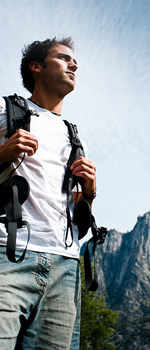
|
Follow Me On: |
 |
Kathleen Petty AVP/Sr Mortgage Originator Global Credit Union Home Loans AK#157293 Phone: (907)261-3458 Cell: 223-4440 Fax: (907)929-6699 License: NMLS Unique Identifier #203077 K.Petty@gcuhome.com https://www.globalcu.org/home-loans/resources/originators/Kathleen-Petty/ |
 | ||
| ||||
April 2008

|
Take a Hike! Bringing Your Workout to the Great Outdoors
The weather is getting warmer and the days are getting longer. Spring is here and it's time to shed the cocoon of winter. Part of this yearly transition involves rediscovering the beauty that lies outside our front doors. But, spring is also about getting ourselves back into swimsuit shape. Follow along as we show you how to shed your "winter coat," while also taking in some much needed fresh air. We're going on a hike. The Benefits of Hiking Hiking also benefits our muscles, especially the legs, abdomen and lower back. Opposing motions during the hike have a lot to do with this. The uphill portion of the hike constitutes what's known as a concentric, or a muscle shortening, exercise. In turn, the downhill portion utilizes eccentric, or a muscle lengthening, exercise. Simply put, it is a complete lower body workout without using weights, and a great way to build lower body muscle. Increasing our muscle mass has been shown to speed up metabolism and to strengthen bones. Hiking is also beneficial to our minds. To begin with, it is an exercise that takes place in the middle of nature, where the air is clean and brimming with oxygen from the surrounding greenery. Increasing the intake of oxygen is key to reducing stress and increasing our mental clarity. Another benefit that hiking brings to our mental state has to do with our body's need for sunlight. If you've read our January 2008 article, Seasonal Affective Disorder: The Truth Behind the Winter Blahs, you know the positive effects that natural sunlight has on both our overall mood and energy level. A little color in our cheeks never hurt, either. Lastly, there is something to be said for the people you meet on a hiking trail. Remember, this is not the hustle and bustle of a city sidewalk. In turn, people who utilize these trails aren't there because they have to be. They're there because they want to be. It's not uncommon to see couples, or even families hiking together. Some people even bring their dog along. The point is that hiking trails are happy places. You'll be surprised at the amount of people who offer an unsolicited "hello" as you cross paths on the hike. Getting Started Start by asking your friends and co-workers. You may be surprised at the amount of people you know who are regular hikers. These people provide a first-hand account of what to expect from any given trail. They also make for great hiking partners. Another place to find information on hiking trails is the Internet. A simple Google search will turn up websites like www.localhikes.com, where you can plug in your zip code and see the trails that are in your area. Many sites offer additional information, such as directions to the trailhead, length of the trail, estimated duration of the hike, difficulty of the hike, and rules regarding pets. Yet another source of information would be your local Department of Parks and Recreation. Start by visiting their website. If any questions remain unanswered, give them a call. The phone number will most likely be listed on their website. What to Bring Your clothing will play a big part in your hike, as there may be nothing more miserable than discovering you are ill-equipped in terms of the weather. Before going on any hike, it is imperative that you are familiar with the weather forecast. Get caught unprepared just one time and you'll see what we mean. In terms of the clothes you choose, the best practice is to think in terms of layers. Opt for clothes that can either be removed or put back on as your hike progresses. A light, waterproof backpack is invaluable to this process. It will provide a dry place to store any items that are not being worn. Regardless of the weather it is always a good idea to pack an extra t-shirt. Changing out of a wet shirt and into a dry one is refreshing no matter the conditions. The same theory applies for bringing an extra pair of socks. Many stores that deal with outdoor sports offer light hiking pants that can be unzipped at the knees and quickly turned into shorts. These are great all-purpose pants, highly versatile and suitable for almost any hike. A hat with a visor is another "must bring" item. It's excellent for keeping the sun off of your face and the sweat out of your eyes. As long as you're bringing along a backpack, you may as well fill it with a few things that will come in very handy. The first is water. It doesn't matter if it's an hour-long hike on two-miles of paved trail or a six-hour journey through more rugged terrain, it is imperative that you pack an adequate supply of water. Whether you drink it or wash your face with it, fresh water is the key to staying properly hydrated. As far as the packing of food is concerned, much depends on the length of your hike. Lighter hikes (one to two hours in duration) may only require you to bring along an energy bar or two. Longer hikes will most likely require a small meal. Sandwiches (without mayonnaise), fresh fruit, and trail mix are perfect examples of high-energy foods that can be easily packed and readily consumed. Here are some additional items to put in your backpack: Sunscreen Sunglasses Cell Phone Other Key Items A Few More Tips... No matter the length of your hike, we would encourage you to inform at least one person of your plans. Let them know where and when you'll be hiking, as well as what time you expect to return. Make plans to call them once your hike is completed. Lastly, when you arrive at the trailhead, be sure to properly stretch before embarking on your hike. It may be a low-impact exercise, but it is quite strenuous on your muscles. Stretching not only helps to prevent injury, it also increases performance. Good luck and... go take a hike! | ||||||||||||||||||||||||||||||
License #AK157293 You are receiving a complimentary subscription to YOU Magazine as a result of your ongoing business relationship with Kathleen Petty. While beneficial to a wide audience, this information is also commercial in nature and it may contain advertising materials. INVITE A FRIEND to receive YOU Magazine. Please feel free to invite your friends and colleagues to subscribe. SUBSCRIBE to YOU Magazine. If you received this message from a friend, you can subscribe online. UNSUBSCRIBE: If you would like to stop receiving emails from Kathleen Petty, you can easily unsubscribe. Global Credit Union Home Loans AK#157293 |
, 125 W Dimond Blvd #110 Anchorage, AK 99515 Powered by Platinum Marketing © Copyright 2024. Vantage Production, LLC. | |||||||||


